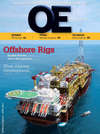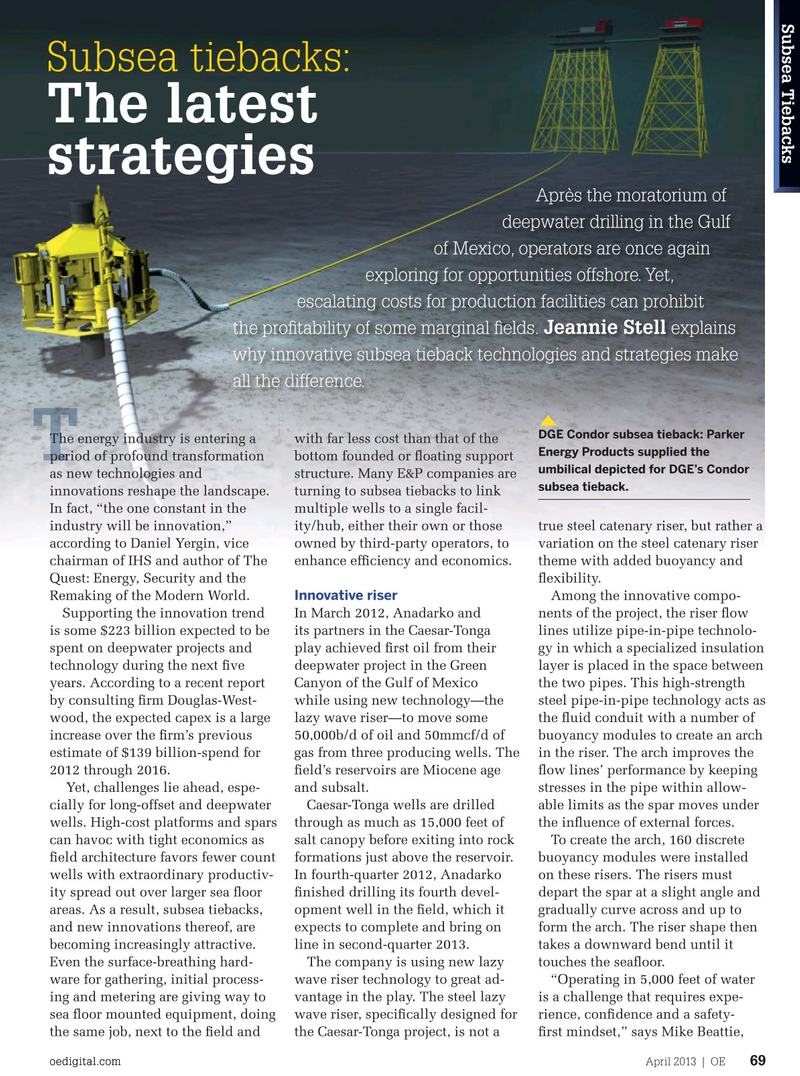
Page 67: of Offshore Engineer Magazine (Apr/May 2013)
Read this page in Pdf, Flash or Html5 edition of Apr/May 2013 Offshore Engineer Magazine
Subsea Tiebacks
Eyebrow
Subsea tiebacks:
The latest strategies
Après the moratorium of deepwater drilling in the Gulf of Mexico, operators are once again exploring for opportunities offshore. Yet, escalating costs for production facilities can prohibit
Jeannie Stell the proftability of some marginal felds. explains why innovative subsea tieback technologies and strategies make all the difference.
DGE Condor subsea tieback: Parker
The energy industry is entering a with far less cost than that of the
Energy Products supplied the period of profound transformation bottom founded or foating support
T umbilical depicted for DGE’s Condor as new technologies and structure. Many E&P companies are subsea tieback. innovations reshape the landscape. turning to subsea tiebacks to link
In fact, “the one constant in the multiple wells to a single facil- industry will be innovation,” ity/hub, either their own or those true steel catenary riser, but rather a according to Daniel Yergin, vice owned by third-party operators, to variation on the steel catenary riser chairman of IHS and author of The enhance effciency and economics. theme with added buoyancy and
Quest: Energy, Security and the fexibility.
Remaking of the Modern World. Innovative riser Among the innovative compo-
Supporting the innovation trend In March 2012, Anadarko and nents of the project, the riser fow is some $223 billion expected to be its partners in the Caesar-Tonga lines utilize pipe-in-pipe technolo- spent on deepwater projects and play achieved frst oil from their gy in which a specialized insulation technology during the next fve deepwater project in the Green layer is placed in the space between years. According to a recent report Canyon of the Gulf of Mexico the two pipes. This high-strength by consulting frm Douglas-West- while using new technology—the steel pipe-in-pipe technology acts as wood, the expected capex is a large lazy wave riser—to move some the fuid conduit with a number of increase over the frm’s previous 50,000b/d of oil and 50mmcf/d of buoyancy modules to create an arch estimate of $139 billion-spend for gas from three producing wells. The in the riser. The arch improves the 2012 through 2016. feld’s reservoirs are Miocene age fow lines’ performance by keeping Yet, challenges lie ahead, espe- and subsalt. stresses in the pipe within allow- cially for long-offset and deepwater Caesar-Tonga wells are drilled able limits as the spar moves under wells. High-cost platforms and spars through as much as 15,000 feet of the infuence of external forces. can havoc with tight economics as salt canopy before exiting into rock To create the arch, 160 discrete feld architecture favors fewer count formations just above the reservoir. buoyancy modules were installed wells with extraordinary productiv- In fourth-quarter 2012, Anadarko on these risers. The risers must ity spread out over larger sea foor fnished drilling its fourth devel- depart the spar at a slight angle and areas. As a result, subsea tiebacks, opment well in the feld, which it gradually curve across and up to and new innovations thereof, are expects to complete and bring on form the arch. The riser shape then becoming increasingly attractive. line in second-quarter 2013. takes a downward bend until it
Even the surface-breathing hard- The company is using new lazy touches the seafoor. ware for gathering, initial process- wave riser technology to great ad- “Operating in 5,000 feet of water ing and metering are giving way to vantage in the play. The steel lazy is a challenge that requires expe- sea foor mounted equipment, doing wave riser, specifcally designed for rience, confdence and a safety- the same job, next to the feld and the Caesar-Tonga project, is not a frst mindset,” says Mike Beattie, oedigital.com oedigital.com April 2013 | OE 6969 oe_flowlines.indd 69 4/1/13 1:57 AM

 66
66

 68
68